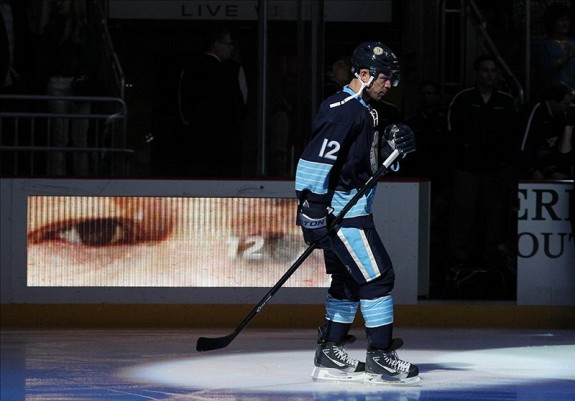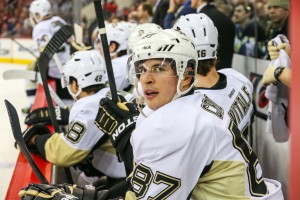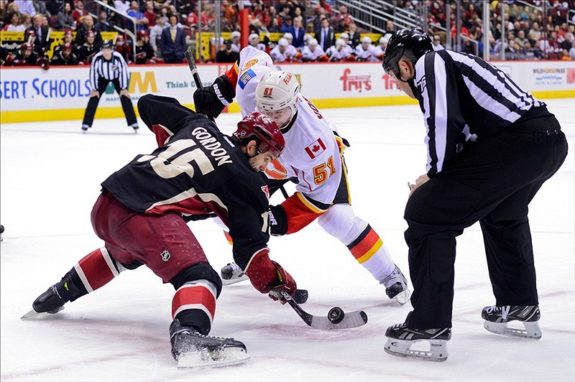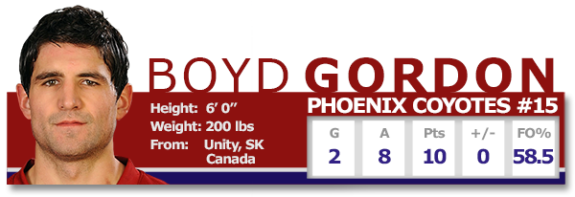
Welp, so much for all that “Dream Team” talk.
Jarome Iginla made his Pittsburgh debut on Saturday afternoon but the Penguins finished the game without Sidney Crosby, Chris Kunitz, Kris Letang, and Paul Martin. That’s two players from their top line and their top two defensemen. $21 million in salaries. Haven’t we heard this tune before?
The Penguins still beat the Islanders 2-0 to extend their winning streak to 15 games but the injury bug is rearing it’s ugly head once again in Pittsburgh. General Manager Ray Shero announced on Sunday that Crosby is out indefinitely with a broken jaw and Martin is out four to six weeks after hand surgery.
With 48 hours left until the trade deadline, does Shero still have one more bullet stashed in the chamber?
When analyzing potential trades, I try to consider the following dynamics:
- What does the team need? How desperate is that need?
- Which teams are going to be looking to trade away players? How desperate are they to trade?
- Are there players on those selling teams that can fulfill needs? Would the players actually fit with the acquiring team?
- What would it cost to acquire those players and how many teams might be interested?
I question just about everything I hear from General Managers within ten days of the deadline and assume it’s simply posturing — even if it doesn’t make sense at the time — but the above questions at least help to narrow down the possibilities.
For example, Boston needs scoring up front and help on the powerplay. Sure, Jaromir Jagr is a possibility. Or how about Brad Boyes? The Islanders are trying to cling to a playoff spot, yet haven’t said a word about trying to extend Boyes, whose contract expires at season’s end. Boyes scored 26 goals as a Bruins rookie in 2006.
Sounds like a pretty good fit, doesn’t it?
What do the Penguins need?
Let’s dig deeper into the Penguins’ situation.
Crosby could be out for weeks and Martin sounds likely to miss the first round of the playoffs. Shero needs to find a first line center and a defenseman that can play 28 minutes a night.
Or does he?
Pittsburgh’s winning streak has done wonders for their confidence, but it’s also propelled them up the standings. They now lead the Eastern Conference by seven points over Montreal and lead the Atlantic Division by 17 points.

If Crosby will be back for the playoffs, do they really need to replace him? Can’t they just plug ‘Swiss Army knife’ Dustin Jeffrey onto the top line temporarily, let the Malkin and Sutter lines develop chemistry, and coast into the postseason?
Martin’s situation is a little more tricky. As long as Letang’s injuries won’t keep him out long term, the Penguins should be fine with defense depth after acquiring Douglas Murray last week.
So what could the Penguins still possibly need?
It hasn’t been easy to find holes in their game during the lengthy winning streak. Coach Dan Bylsma finally has his team playing solid as a defensive unit and the goaltending from Marc-Andre Fleury and Tomas Vokoun has been superb.
The one hole I’ve noticed over the past few weeks is faceoffs.
It sounds like such a simple aspect of the game, but it can be critical come playoff time when one defensive zone faceoff in overtime can determine a series.
Brandon Sutter has done a reasonable job when taking defensive zone faceoffs on the right hand side of the ice. He’s been just short of awful on the left side though. Crucial faceoffs on the penalty kill haven’t been any better.
It recently reached a point where Bylsma was sending Crosby onto the ice to take left side draws on the penalty kill, only to yank Crosby off the ice immediately after he wins them. That’s not efficient use of the best player in the game.
The next question to consider is how desperate is this need for the Penguins?
After acquiring Jarome Iginla, Shero told the Penguins website that he still had plans to work the phones up until the April 3 deadline:
We’ll continue to talk to teams and see what teams are doing and what’s out there. We’re pretty good at this point. We’ll get everyone in and playing and see what next Wednesday brings us.
On Sunday, after finding out he might be without Crosby and Martin for an extended period of time, he told the Tribune-Review’s Rob Rossi that he was done trading:
#TribHKY >> "We've made the moves we're going to make, I think." Shero on Crosby injury impact before #NHL trade deadline. #pens
— Rob Rossi (@Real_RobRossi) March 31, 2013
Perhaps Shero saw the prices being asked for players over the weekend and decided to pull out of talks with other teams. Or perhaps he knows opposing GM’s will drive a harder bargain if they know he’s actively looking for players.
I don’t know which scenario is true, but I do know Shero has always said he’ll “continue to look for ways to improve our hockey club.”
Always.
I don’t think he closes up shop when there’s still the potential for teams to unload players for great prices at the last minute.
Which teams are looking to trade?
This is probably the easiest question to answer.
Playoff teams will be looking to add and non-playoff teams will be looking sell off players for assets.
According to SportsClubStats.com, the #9 Edmonton Oilers only have a 23.8% chance of making the playoffs. Dallas, Columbus, Nashville, Phoenix, Calgary, and Colorado all have less than a 20% chance in the Western Conference.
In the East, the New York Rangers are still clinging to hope (42.9%), but Washington, NY Islanders, Tampa, Philadelphia, Buffalo, and Florida all have less than a 30% chance of making it.
Who is available and can fill a need?
It can be tougher to predict who is available unless certain names leak out into the media.
Buffalo’s Steve Ott would be a perfect pickup for a playoff team with a need for a center with grit and faceoff abilities. Will the Sabres actually trade him for anything less than a king’s ransom though? Buffalo is trying to rebuild and Ott still has one year left on his contract. He’s the perfect character player to have in the lineup to make sure next season gets off on the right foot.
Maybe he gets dealt to a team with a desperate center need like Vancouver, but it probably won’t be the Penguins after they just unloaded a number of high draft picks and prospects last week.
A rental (player who will be a free agent this summer) is more likely.
When considering rentals who are strong on defensive zone faceoffs, Adam Hall is an option. Hall played for Shero in Pittsburgh in 2008, although he isn’t quite the same player he was back then. He was recently placed on waivers by the Tampa Bay Lightning and after being claimed by Carolina he’s been unspectacular at best.
Even if the price to acquire is minimal, Hall probably isn’t better than the Penguins’ internal options of Tanner Glass and Joe Vitale.

When screening for possible players, one name stuck out like a sore thumb: Boyd Gordon.
Last summer, I had a chance to catch up with Phoenix Coyotes Assistant GM Brad Treliving and he described how important Gordon was to their Moneyball-style free agency plan in 2011:
“You’ve really got to say, okay, what are we looking for, and what are we replacing? Well an area that we really wanted to improve was faceoffs. So we look for a faceoff person, one that can kill penalties, can play in certain situations against top lines, can defend well, but we also think that if given more ice time he can produce at a higher level.
Boyd Gordon was a guy we pursued hard on July 1 and he’s been excellent in that role for us.”
Gordon will be a free agent this summer and Phoenix GM Don Maloney recently said that he was close to unloading players for assets if their playoff chances didn’t quickly improve.
They haven’t.
Playing for Phoenix doesn’t exactly enhance your reputation, but Gordon is widely regarded as a faceoff whiz around the league. Over the past five seasons he’s been exactly the player Treliving described. He’s dominating faceoffs in the defensive zone in particular if these stats are any indication:
- 2008-09: 59.42%
- 2009-10: 58.43%
- 2010-11: 58.09%
- 2011-12: 56.50%
- 2012-13: 57.98%
Penguins coach Dan Bylsma has been reluctant to use Glass and Vitale on the penalty kill lately, meaning Gordon could be a valuable addition to the shorthanded unit as well. He’s won more shorthanded faceoffs than anyone in the league this season, while Sutter has won just 50 percent of his attempted draws.

Gordon seems stronger on his right side than his left, but players don’t win nearly 60 percent of their draws each season without dominating in every circle. He scratches and claws on every faceoff and is willing to risk limbs to block shots and win puck battles.
Boyd Gordon is everything you want out of a fourth liner in the playoffs.
He’ll also be the trade that goes totally under the radar between now and April 3.
Imagine overtime. Game 6. The Penguins are shorthanded with a faceoff to the left of Marc-Andre Fleury (remember, faceoffs are always in the defensive zone immediately following penalties).
If Pittsburgh wins the faceoff, the puck is cleared and 30 or more seconds go off the clock.
If Pittsburgh doesn’t win the faceoff, pressure is sustained and there’s a good chance the puck ends up in the back of the net.
It’s a fine line between a play you’ll never remember, and a play you’ll never forget.
In that sense, Boyd Gordon’s presence could be every bit as important as Brenden Morrow, Jarome Iginla, and Douglas Murray.
By Wednesday at 3pm, we’ll know if the final hole has been filled.
___________________________________________